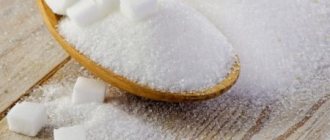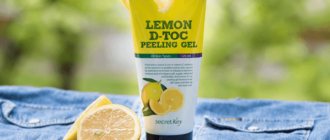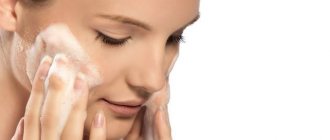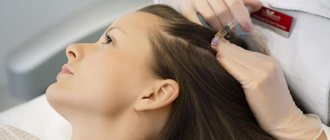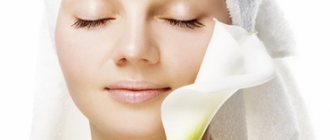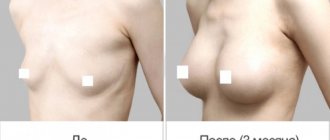Glycolic peeling is a procedure whose demand is confirmed by positive reviews from patients and specialists. Popularity is associated with the effectiveness of the method for solving not one, but a number of problems. It is well known that the “stronger” the remedy, the more carefully you need to handle it, understand the nuances, and adhere to the authoritative opinion of experts.
Glycolic peeling
Peeling at its core is the exfoliation of dead skin cells of the epidermis - the surface layer of the skin. Glycolic peeling is a type of chemical peeling and is achieved by the action of fruit acids on skin cells. Unlike the natural processes of skin renewal, it is much more active and, according to some experts, more aggressive.
The glycolic version of the peel is considered quite aggressive
What is useful to know about glycolic peeling? How not to make a mistake in the “pros and cons” question? How to avoid side effects during its implementation? Is it worth practicing it at home? The answers to these questions will help you make the right choice.
From the history
The first mentions of glycolic peeling were found in historical facts about Ancient Egypt. We are talking about using sugarcane juice for rejuvenation. Indeed, this acid is found in the juice of many fruits: sugar beets, green grapes, pineapples.
Interesting ! The method emerged as a cosmetic procedure in the second half of the 20th century. This is due to advances in the study of the properties of glycolic acid. In addition to peeling itself, it promotes collagen synthesis and solves the problems of “aging” skin.
The technique originated in the second half of the 20th century
The introduction of the method into practice was preceded by clinical experiments. One of these took place in 1996. An experimental group of 41 people was created, which included patients of different ages and initial skin conditions.
Once a week, a 50% solution of glycolic acid was applied to the skin. The experiment was carried out over 4 weeks. After carefully studying the results, scientists came to the following conclusions: the layer of “dead” cells decreased, the layer of functioning epidermal cells increased, and the photosensitivity of the skin decreased. Particularly interesting were the results in the form of rejuvenation and the disappearance of fine wrinkles.
Important ! Changes occurred in 90% of study participants.
Documentary confirmation of this fact contributed to the introduction of the procedure into cosmetology practice.
The experiment has proven the effectiveness of such a remedy
What is milk-glycolic peeling?
This type of peeling is the mildest type of acidic effect on the skin. Provides comprehensive care:
- improves blood circulation,
- accelerates collagen production;
- moisturizes tissues;
- prevents the appearance of acne
The procedure does not cause skin complications and does not damage the skin. Main components: malic acid, milk proteins. You need to apply the product 1-2 times a week, after application you should massage the skin for 2 minutes, rinse off the composition with cold water.
What is a glycolic peel?
Peels using fruit acids have been around for a long time and are time-tested. Popular categories include milk, almond, lemon. They contribute to the renewal of the surface layer of the epidermis - the stratum corneum. Glycolic peeling has the properties of all the previous ones and also has a rejuvenating effect on the deeper layers, thanks to the high penetrating ability of the active substance.
Important ! This provides the effect of evening out skin color and getting rid of fine wrinkles.
Fruit acids have an effective effect on the skin
Indications for use of peeling
Peeling can be used by women of any skin type. It is suitable for girls with fair skin, with freckles, and dark-skinned women with less vulnerable skin.
Acid has varying degrees of concentration. With a gentle action, the top layer of skin is affected. Sometimes a medium peel should be carried out, penetrating even deeper into the skin.
For clients aged 35-45 years, peeling eliminates fine wrinkles. Patients over 50 years of age should choose a type of peeling with a stronger effect. The method will fix the problems:
- scarring;
- stretch marks;
- wrinkles;
- freckles.
Properties of glycolic acid and benefits for the skin
The source of glycolic acid is natural products. By chemical nature it is an acid. Like any active substance capable of entering into chemical reactions, its effect depends significantly on concentration.
Concentration affects the result
Let's consider the main properties of hydroxyacetic acid that contribute to beneficial effects on the skin.
- Glycolic acid has a small molecular weight and has the ability to penetrate deep into the skin, where it effectively breaks down keratinization, entering into chemical reactions and disrupting the connections between dead cells.
- The active substance promotes the production of collagen and fibroblasts. Externally, this effect manifests itself as a rejuvenating effect: skin elasticity increases, facial tone is evened out.
- The exfoliant provides a lifting effect due to its effect on connective tissue cells: deep wrinkles are smoothed out and become less noticeable, fine wrinkles disappear, and the overall relief is evened out.
- Peeling helps to “cleanse” the skin. Thanks to the anti-inflammatory effect, the procedure has a therapeutic effect on acne and helps to reduce the inflammatory process.
- Along with other effects, a hydrating effect is manifested, which is possible due to the ability of the exfoliant to be saturated with water molecules. Experts and patients note the softness and optimal hydration of the skin.
Glycolic peel moisturizes skin - The manifestation of acid properties has a regulating effect on the acid-base balance in tissues. This stimulates microcirculation, optimizes secretion production by the sebaceous glands and has a noticeable effect on the overall condition of the skin.
- Hydroxyacetic acid eliminates the effect of excessive pigmentation.
- One of the properties of this substance is to smooth out minor scars and scars.
- The product has a complex effect, reveals itself on many levels: improves elasticity, refreshes the skin, evens out its texture, moisturizes, and cures acne. The effect of this procedure appears on the skin of people of all age categories.
- If the indications are followed and there are no contraindications, glycolic peeling acts carefully, within the boundaries of the problem area and the assigned tasks.
This peeling is gentle on the skin.
Peeling, like any cosmetic procedure, can lead to undesirable results. It is not enough to read the indications and the procedure to repeat it yourself. Glycolic peeling, especially when using a high concentration of the drug, is safe if performed professionally.
Important ! Despite the fact that the method is relevant for almost any skin type and at different ages, an individual approach always comes to the fore. An experienced specialist will conduct a session taking into account the characteristics of the skin, age, and somatic diseases.
An individual approach to the procedure is required
Glycolic acid
This acid belongs to the group of fruit acids. As a rule, it is found in its natural form only in cane and unripe grapes. This substance quickly penetrates the upper layers of the skin due to its low molecular weight.
Glycolic acid peeling at home is a treatment of the skin surface with an acid solution. Such solutions allow you to remove dead cells, dirt particles, dead cells, and toxins from the surface. The solution does the following:
- activates internal processes of the body;
- accelerates cellular regeneration;
- produces collagen;
- cleanses the upper layers of the skin;
- reduces skin production;
- moisturizes the skin;
- reduces wrinkles;
- protects the skin from sun rays;
- makes pigment spots less noticeable;
- reduces the number of acne;
- improves skin tone.
When the top layer of the skin is destroyed, the body begins to quickly produce its own collagen. Due to this, the skin is renewed, looks healthier and fresher. Moreover, improvements in appearance can be noticed within a few hours.
Types of glycolic peeling
Due to different tasks, there are two types of glycolic peeling.
- Superficial exfoliation is carried out using acid with a concentration of up to 40%. The pH level ranges from 2.4 to 4.5. The main effect of this procedure is the removal of dead cells from the surface of the epidermis. Experts recommend it to young patients to even out the relief and tone of the face, and regulate the secretions of the sebaceous glands. The expected result is fresh skin in a fairly short period of time. For example, the need to look presentable before an important event.
Superficial exfoliation - Aggressive peeling provides a deeper effect on the skin. This is understandable, because the concentration of the active substance increases. The content of hydroxyacetic acid reaches 70%, and the hydrogen index is at least 2.8 (the lower the index, the more pronounced the properties of the substance as an acid). The depth of impact of such peeling is assessed as superficial-medium or intermediate. The drug penetrates the dermis and causes a more active response: pronounced redness of the skin, peeling, and the formation of a brown crust. The pain of the procedure increases due to these features. When reading the symptoms described above, it is worth remembering that this is the price of a more pronounced result. This procedure is more suitable for patients over 30 years of age.
Aggressive exfoliation
How to do a glycolic peel at home
The peeling agent is purchased at the pharmacy. If the procedure is carried out at home, you should be prepared to deal with unforeseen situations in the event of a complication. 2 weeks before the process, comprehensive measures are required using a preparation kit: skin cleanser, day and night cream.
After the preparation time has expired, a cleanser is applied to the skin. After rinsing your face with water, apply a peeling composition. The mask lasts no more than 3-5 minutes. If irritation or swelling occurs, the product is washed off immediately.
It is necessary to remove any remaining acid using a damp towel or napkin. Do not wash your face with acid on your face to avoid getting it in your eyes. After washing off the composition, restorative agents are needed.
Indications
Exfoliation with glycolic acid is indicated if:
- even out the relief of facial skin, get rid of residual effects of inflammatory processes;
- prevention of premature aging;
- treat comedones and acne;
- restore or increase skin elasticity, achieve a lifting effect due to the disappearance of facial wrinkles;
You can achieve skin elasticity - moisturize the skin, improve its elasticity;
- support the skin after excessive sun exposure;
- correction for thickening of the stratum corneum of the epidermis;
- get rid of age spots (with the exception of cases of systemic diseases);
Peeling gets rid of age spots - regulate the secretion of the sebaceous glands during seborrhea;
- eliminate the effect of enlarged pores;
- treat viral dermatosis caused by molluscum contagiosum;
- eliminate defects in the form of shallow stretch marks;
- prepare for face resurfacing or plastic surgery.
Glycolic peeling can be used before other procedures
What it is?
At its core, glycolic peeling (glyco-peeling) is a type of chemical effect on human skin using fruit acids. An aggressive technique effectively helps exfoliate the stratum corneum of the epidermis .
Peeling with fruit acid has been known to the world for a long time and has been time-tested more than once. The most popular methods are:
- citric;
- almond;
- lactic.
Glycolic peeling is also able to penetrate deeply into the layers of the dermis, providing a rejuvenating effect. Glycolic acid activates the production of fibroblasts and new collagen.
At the same time, metabolism improves at the cellular level; new, younger and more elastic cells are formed in place of dead cells .
Glycolic peeling improves the condition of the dermis, restoring its elasticity and tone. After the procedures, the face becomes fresher and whiter, gets rid of pigmented spots and freckles. It is enough to undergo at least 5 procedures to see the amazing result of skin transformation. To obtain excellent results, exfoliation should be completed in courses.
Important! Glycolic peeling will provide color alignment of the skin surface, while eliminating fine wrinkles.
Beneficial properties for the skin
The main source of anti-aging acid is natural products containing natural acid. The active substance takes part in a chemical reaction. The final result will depend on the degree of its concentration.
Basic properties of acid for skin:
- Small molecular weight, capable of penetrating deeply into the layers of the dermis.
- Acid effectively eliminates keratinization, enters into a chemical reaction, and disrupts communication in obsolete cells.
- The active substance helps produce collagen and fibroblasts, which increase skin elasticity.
- Exfoliation has a lifting effect on the skin, smoothing out wrinkles and evening out the overall texture.
- The peeling procedure has an anti-inflammatory, moisturizing effect.
We recommend: What is the difference between Jessner peeling and retinoic peeling and which one is better to choose for chemical cleansing of facial skin?
Algorithm for carrying out in the salon (3 steps)
Indications for glycolic exfoliation cover patients with almost any type of skin and different age groups. In addition, there is a selective depth of action of the active substance, which allows you to regulate the effects and their intensity.
There are different peeling tactics based on the use of exfoliants with different concentrations. For example, the first two sessions are carried out with a low content of glycolic acid, within 20%. Further, in increasing order, from 35% to 50% of the solution until the final effect in the form of final peeling.
The acid concentration increases gradually
So, the process is safely controlled by the choice of concentration and application layers. It is important that all the nuances are able to be clarified, taken into account and developed by a medical specialist with experience in this field. Therefore, the best option is to go to the clinic and trust the professionals.
It is worth noting! An important argument in favor of a salon procedure is that the skin must be properly prepared.
It's better to trust the professionals
Over a two-week period, the skin is treated with a low-concentrated solution of hydroxyacetic acid to break the bonds between the obsolete cells of the surface layer of the epidermis. Due to its low molecular weight, the drug gradually penetrates into the deeper layers of the skin, increasing their sensitivity.
Pre-peeling preparation can be carried out at home, using cleansers, lotions and creams selected on the advice of a doctor.
Then it’s time for the actual salon procedure.
Preparation for the procedure is required
There are three stages in its implementation.
- Immediately before peeling, the skin is treated with a special cleansing and degreasing agent.
- An even layer of glycolic acid of the selected concentration is applied. The exposure is maintained. The patient is warned that he will feel skin tingling, itching or tingling.
- A solution is applied - a neutralizer, which stops the action of the acid. At the end of the procedure, the skin is moisturized with cream.
The procedure is carried out in three stages
To reduce the unpleasant burning sensation during exfoliant exposure, use a special device that blows on the skin. This reduces pain without interfering with the effect of the procedure.
Important ! The time of exposure and the specifics of the session are all controlled by a specialist.
Varieties
There are several types of peeling technique using hydroxyacetic acid . Each procedure differs from each other in the percentage of the active substance. Let's look at the main options.
Surface
To carry out superficial exfoliation, concentrated glycolic acid is used up to 40%, where the pH value corresponds to a level of 2.4–4.5. The main effect of the technique is the rejection of the keratinized layer of the epidermis.
According to experts, this type of peeling is suitable for young women , for example, if you want to even out the tone or texture of the skin, or normalize the functioning of the sebaceous glands. After several procedures, the skin will become fresh and smooth. To some extent, this is an “ambulance” before an important event.
We recommend: Advantages and disadvantages of different types of peeling and facial cleansing. Which of these procedures is better?
Deep
This type of peeling is more aggressive and deeper, since the composition contains a high concentration of the main active ingredient - glycolic acid. The drug penetrates deeply into the layers of the dermis, so an active response can be observed. It could be:
- skin redness;
- formation of a brownish crust;
- peeling.
Main components:
- hydroxyacetic acid - with a concentration of up to 70 percent;
- the pH level should not be lower than 2.8 (a low indicator indicates the severity of acidic properties).
Due to the listed indicators, a procedure with a 70 percent acid composition can be painful .
Do not be afraid of such peeling; local anesthesia may be used during the procedure. As a result, girls get more pronounced results.
The technique is suitable for any skin type and age category. An experienced specialist must take an individual approach to each client, taking into account skin type and concomitant somatic diseases.
Features of care after the procedure
It was previously said that the effects of peeling can be strong and cause a number of responses in the body. In fact, the effect of acid has been compared to a burn. Therefore, before the procedure, the doctor prepares not only the skin, but also the patient himself - he tells in detail what rules must be followed, how the rehabilitation period proceeds.
One of the frequent questions that patients ask is how quickly the pain and burning go away. Usually, the discomfort goes away with the end of the session. In case of hypersensitivity, it may persist in a mild form the next day.
Unpleasant sensations usually go away with the end of the session
Potential reactions also include swelling and redness of the treated area. Their intensity depends on the characteristics of the skin and the depth of peeling. But most often the period of maximum manifestation is several hours after manipulation.
Sometimes brown crusts form. They should never be removed, as additional trauma may lead to scarring or areas of hyperpigmentation.
Peeling is an expected skin reaction after peeling. To reduce discomfort, you can use moisturizing creams recommended by your doctor.
Your skin may peel, and that's normal.
Therapeutic effects, the time of their manifestation, the boundaries of normal sensations are discussed with the doctor. If an unexpected reaction occurs, you should contact a specialist.
The course consists of sessions, the number of which is determined by the doctor. Usually from 4 to 10 manipulations are performed. The amount may vary depending on the initial condition of the skin, age, and problems being solved.
The doctor, considering each individual case, determines the required number of procedures
Skin care continues between sessions. Usually it involves treatment with weak solutions of hydroxyacetic acid to consolidate the result.
It is best to plan glycolic peeling in the autumn-winter season, so as not to expose the skin to the aggressive effects of ultraviolet radiation. And even when the sun is not too active, it is worth using sunscreen with an SPF effect of at least 30.
It is better to carry out the procedure in autumn or winter
Important ! During the course, you should avoid active water procedures, visiting the sauna, bathhouse, and swimming pool.
How is glycolic facial peeling performed in beauty salons?
- Preparation.
If you are doing a glycolic peel for the first time, you need to prepare your skin in advance for the effects of the active substance. To do this, apply products with one of the acids to your face every evening: citric, mandelic or glycolic. Almond is weaker than the others, so it can be safely used to treat sensitive skin.
- Peeling.
The procedure begins with cleansing the skin of impurities and cosmetics. Next, the specialist proceeds directly to peeling. The acid is applied to the forehead, chin, nose and cheeks. The area around the eyes should remain untouched.
The exposure time of the drug ranges from 2 to 15 minutes. The exact period should be selected by a cosmetologist, taking into account the sensitivity of the epidermis and the concentration of acid in the chosen product. During the procedure, you must carefully monitor the skin's reaction. If redness, itching and burning begin, a specialist should remove the mixture.
Glycolic facial peeling is removed with a neutralizer. After this, the skin should be rinsed with cold water and a nourishing mask should be applied.
- Recovery phase.
A nourishing mask after the procedure is enough for the skin to recover. However, if desired, you can use a sedative. Choose formulations with wheat oil, jojoba oil or grape seed extract.
To avoid negative consequences from the procedure, follow the following rules for further skin care:
- During the recovery period, you should stop using decorative cosmetics.
- It is also recommended to avoid visiting baths and saunas.
- To ensure that glycolic acid facial peeling gives the desired effect without skin irritation, apply a strong sunscreen before sun exposure.
Read material on the topic: Fruit peeling: in a beauty salon and at home
How to carry out the procedure at home?
It is possible to remove dead cells and improve skin condition at home.
Cosmetics manufacturers produce ready-made formulations of safe concentrations for carrying out the session yourself. An important condition for the effectiveness of salon and home procedures is the preparation of the facial skin. For this purpose, cosmetics containing fruit acid (usually a small concentration) are applied for 1-2 weeks. The drug is applied once before bedtime.
Preparation before the procedure is important
Let's consider the procedure for carrying out the manipulation.
- The composition is applied to clean skin. The face is rinsed with water and gently, without rubbing, dried with a clean towel.
- The peeling preparation is applied using a fan-shaped cosmetic brush. The instructions describe the amount of the drug to be applied (one layer) and application patterns. The sequence should be followed: chin, nose, forehead, cheeks. It is important to avoid getting the peeling agent on the area around the eyes. Movements should be neat, smooth, without pressure.
- An important point is the exposure of the drug. The recommended time ranges from 2 to 15 minutes. It depends on the individual characteristics of the skin, age, and characteristics of the peeling product (primarily concentration).
- After the designated time, the facial skin is treated with a neutralizer. A solution of baking soda will do this role perfectly: a teaspoon of the substance per glass of water. Soak a cotton swab with the prepared mixture and carefully remove the exfoliant from the treated area.
- Residues are washed off with water. Usually the procedure ends with the application of a moisturizer or action mask. For this purpose, you can use a product containing jojoba oil.
The full course includes 4-6 procedures. For safety reasons, a gap of 1-2 weeks must be maintained between sessions.
It is necessary to take breaks between courses of therapy
It is worth noting ! It is important to be attentive and careful when carrying out the procedure yourself. At the first sign of a problem, you must end the session.
To properly navigate the situation, let’s look at the list of possible complications.
Stages
Any chemical exposure must consist of three stages:
- Preparation before peeling. The rationality of the procedure must be determined by a cosmetologist; he also pays attention to the degree of exposure to the components, determines how susceptible the skin is to aggressive components, and eliminates contraindications.
- The exfoliation itself. It is recommended that the peeling be applied by a cosmetologist, taking the necessary precautions, but every girl can carry out the rejuvenation process at home. The duration is from 5 to 15 minutes. In between rejuvenation and improvement of the condition of the epidermis, it is recommended to use cosmetics with a minimum content of aggressive components for maximum effectiveness.
- After application. The cosmetic procedure will not disrupt the girl’s usual rhythm of life. It is enough to apply moisturizers and cream with SPF 30. For two weeks after applying the product, it is better to avoid aggressive exposure to the sun; it is forbidden to visit the solarium and collagenarium. Competent pre-peeling preparation and necessary care after applying the product will ensure the desired result.
Unpleasant consequences after peeling
Glycolic peeling can have side effects and complications associated with various reasons.
- High acid concentration and increased exposure time can cause first or even second degree burns. At the first signs of deviation of the procedure from the normal course, you should neutralize the effect of the acid and contact a specialist. It is also worth getting advice about the next sessions. They are carried out after the completion of the rehabilitation period.
- Hyperpigmentation in the post-peeling period may occur due to increased skin sensitivity. Therefore, the specialist must warn you about the need to follow the following rules: use sunscreen, carry out the procedure in the autumn-winter period. By following the recommendations, you can avoid the appearance of age spots on your facial skin.
- Allergic reactions can be minimal or significant - from itching, rash to systemic reactions. The best way to prevent such complications is to conduct a test. A detailed description is available in the instructions for the drug.
Allergies may occur as a result of exposure to fruit acids - It is worth remembering that severe swelling on the face can lead to difficulty breathing. In such cases, call emergency services immediately.
- If the allergic reaction is not life-threatening, you should neutralize the acid and consult a doctor.
- Peeling is accompanied by a feeling of dryness and tightness of the skin. The specialist will prescribe a suitable moisturizer.
Glycolic peeling at home is possible and safe if you follow the rules, recommendations of specialists, and instructions for the drug. The best protection against complications is their prevention.
It is worth considering the possible consequences in advance
Description of the procedure and indications for facial peeling with glycolic acid at home
Glycolic peeling – what is it? The main component of this type of peeling is glycolic acid, thanks to which the top layer of the epidermis is well removed. This makes the skin fresher, makes it soft and velvety. Exposure to such a substance evens out the relief, narrows enlarged pores, and also helps in the production of elastin and collagen.
Glycolic peeling at home
Glycolic peeling is one of the most gentle procedures because it only affects the upper layers of the skin. This allows you to overcome age spots, unsightly acne and small scars. And after the procedure, facial wrinkles will decrease. Depending on the desired result, different concentrations of acid are used (usually 30 or 80%).
The advantage of glycolic peeling is that cleansing is suitable for all types of epidermis. To carry out these manipulations, there is no need to use anesthesia, since the peeling takes place without any discomfort.
Facial peeling using glycolic acid is prescribed by cosmetologists to solve many problems:
- to combat pigmentation, acne, scars and various spots;
- to get rid of blackheads and enlarged pores;
- to even out the relief of the epidermis.
Video shows glycolic peeling at home:
This procedure also prevents age-related skin changes and prevents photoaging. Exposure to glycolic acid helps in rehabilitation after plastic surgery on the face. Peeling is also used as weekly care for the epidermis. Cosmetological manipulations are allowed to be carried out on different areas of the face, as well as in the décolleté, neck and other areas of the body. Glycolic acid is suitable for women of any age category. You can learn about peeling with soda in this article.
Contraindications
Before agreeing to the procedure, it is worth studying the contraindications in detail:
- signs of inflammation and damage to the integrity of the skin in the peeling area;
- allergy to exfoliation preparations or their components;
- symptoms of exacerbation of herpetic infection or its consequences;
- benign and malignant skin tumors;
- rosacea;
- use of products containing vitamin A analogues;
Products containing vitamin A analogues are not allowed during the course of procedures. - pregnancy, lactation period;
- pigmentation disorders due to systemic diseases;
- increased skin sensitivity to ultraviolet radiation;
- condition after chemotherapy;
- fresh tan;
- spring-summer season;
- age less than 15 years.
Contraindications should be taken into account
If you want to combine several cosmetic procedures, you must inform your doctor about your plans. Some of them may not be compatible.
Cost of drugs
Among the companies producing glycolic peeling products, we can note products from Belita-Vitex (50% concentration with an pH value of 2.5), as well as from Medical Collagene 3D Easy Peel (10% concentration with a pH value of 2.8 ). The products are available for purchase in cosmetic stores, pharmacies or online stores.
Products produced in Russia can be purchased at prices ranging from 500 to 2,500 rubles, depending on the number of milliliters. Belarusian manufacturers offer their drugs at a price of 1,000 – 1,500 rubles per 250 ml bottle.
Many factors determine the cost of drugs
We will indicate the cost of the procedure in clinics in different cities of Russia.
| City | Average cost per procedure |
| Moscow | 2600 rub. |
| Saint Petersburg | 1950 rub. |
| Samara | 1600 rub. |
| Voronezh | 1730 rub. |
| Vladivostok | 1520 rub. |
| Rostov-on-Don | 1930 r. |
| Eagle | 2050 rub. |
How to do it at home: step-by-step procedure protocol
You can remove the keratinized layer of the dermis and dead cells using a peeling procedure at home. Let's look at the step-by-step instructions for the cleaning procedure :
- Rinse your face with water and dry with a fluffy towel without rubbing. Apply the acid composition to prepared and cleansed skin.
- The peeling preparation is applied with a cosmetic brush in the form of a wide fan with smooth movements.
- Usually, the attached instructions describe the scheme according to which the skin is treated with the substance. The main thing is to follow the sequence: chin, nose and forehead area, cheeks. Make sure that the acid does not come into contact with areas near the eyes.
- Exposure to glycolic acid is an important point in the procedure. It is recommended to leave the mixture for 2–15 minutes. Take into account individual skin characteristics, age, and drug concentration.
- After some time has elapsed after the procedure, the skin must be treated with a neutralizer, and the most common soda solution is suitable for neutralizing at home. They wipe the face with it and remove the acid.
- The last stage is washing with water and applying moisturizer.
We recommend: Classification of peelings for facial skin and top best products for use in the salon and at home
Video detailing glycolic peeling at home:
How often can I do it?
It is difficult to decide on your own how many times you can do this peeling facial procedure. An experienced cosmetologist will give advice.
Here it is important to take into account the condition of the skin before the sessions, the age group, as well as obtaining the desired result after the procedure.
It will be enough for one patient to undergo one peeling session to see visible changes. For another person, even ten may not be enough to get a good effect. On average, one course includes 5 sessions . This is quite enough for a noticeable result. The maximum number is 10 procedures, then a long break.
It takes about 1–1.5 weeks to restore the surface. Only after this will the next peeling procedure be applied.
If the patient has undergone deep peeling with glycolic acid, then the next session is no earlier than 90 days later.
The cosmetologist examines the condition of the skin and decides on the need and advisability of the next stage of cleansing. The result of the technique will directly depend on the professionalism of the specialist . Therefore, you need to approach the choice of a salon and specialist thoroughly.
How many layers can you apply?
It is customary to apply the peeling agent in one thin layer. For processing, use a wide cosmetic brush in the form of a fan. Walk along the main lines, adhering to the diagram. All movements are smooth, do not press. It is important to ensure that the composition does not get into the eyes or eyelids.
The duration of the peeling procedure is 2–15 minutes.
If the peeling product was purchased at a cosmetic store, it should not cause side effects such as redness of the skin, itching or burning.
Questions
Can glycolic peeling be performed on patients with sensitive skin?
If there are no medical indications, it is better to consult a doctor and replace the glycolic peel with another suitable procedure.
If there is an allergic rash on the skin, can peeling be performed?
The rash can be a manifestation of serious illnesses. Therefore, first of all, it is worth finding out the cause and carrying out treatment. The possibility of carrying out the procedure depends on the results obtained.
How long does recovery after peeling take?
The recovery and healing time of the skin depends on the concentration of the product and individual characteristics. After using drugs with low concentrations, the recovery period takes up to 3 days. After using more intense products, the period can reach up to 10 days.
The procedure is quite interesting
HOW IT’S DONE IN THE SALON
Preparatory stage
Many cosmetologists talk about the mandatory preparatory stage before oxyacetic exfoliation, but only for some patients.
Special preparation may not be required, except for restrictions on tanning 2 weeks BEFORE.
We recommend: What types of PROFESSIONAL FACIAL PEELINGS are there: from diamond chips to vulcanite
If the specialist has prescribed preparatory measures, then the patient 7-10 days before the procedure begins to use cosmetics with a small percentage of the active substance: 3-5-10% acid with 3-5 pH.
As a result, the epidermis softens and adapts to the upcoming impact.
Preparation for different skin types
| Skin type | Recommendations from cosmetologists |
| Oily/combination | Days 1-7: 1 time per day; Day 7-10: morning and evening |
| Normal | Days 1-10: morning and evening when dryness appears - 1 time per day |
| Dry | Days 1-10: 1 time per day |
Glycolic facial peeling requires an allergy test 2 days before the session.
To do this, apply a little exfoliant to the inner bend of the elbow or forearm.
If swelling, abnormal burning and itching appear, then you will have to choose another beauty method (for example, a milk or almond exfoliant).
Sesderma MEDIDERMA Mediccontrolpeel
Main stages of the procedure
It is up to the patient to decide whether to do a glycolic peel in a salon or at home: it is only important to remember that products for home use cannot contain more than 10-15% acid.
Moreover, even the use of gentler products is best discussed with your doctor.
Stage 1. Cleansing and degreasing
Before exposure to hydroxyacetic acid, the face:
- Cleanses with milk, lotion or gel from sweat, dirt and makeup;
- Degrease with lotion to cleanse the sebaceous ducts.
Stage 2. The session itself
- Peeling with glycolic acid is poured into a special container. Then, using cotton swabs, a brush or a spatula, spread it over the surface: in the direction from the forehead to the chin, avoiding the area of the lips and eyes. Several layers can be applied.
- For better penetration of the composition into the epidermis, a light massage can be performed at the same time.
- If tingling or burning is felt, fan the patient or turn on a fan.
Stage 3. Neutralization
In case of abnormal redness of the face, pain or swelling, it is recommended to immediately neutralize the composition with the supplied alkaline solution.
At home, products from pharmacies or specialized stores are washed off with cool water.
- After a few minutes, according to the procedure protocol (depending on pH and % acidity), the product is neutralized until the burning sensation stops completely.
- A soothing mask is applied to the face for 5 minutes, then rinsed off and UV-protective moisturizer is applied.
The whole session lasts approx. 10-25 minutes.
The cost of one glycolic cleaning session in a salon ranges from 20 to 50 euros.
Reviews
Elena, Vladimir
“The purpose of my visit to the salon was to get rid of acne and age spots. The doctor used the drug with a high concentration of 70%. The course consisted of 10 procedures. I had to spend some time at home, but I really liked the result. Getting rid of fine wrinkles was a bonus.”
Women are satisfied with this peeling
Svetlana, Saratov
“I decided to have the procedure because of the onset of age-related problems. I heard that glycolic peeling is a powerful stimulant for the skin. The skin reaction was very strong - redness, swelling. On the advice of a cosmetologist, I used cosmetic Vaseline. But I achieved the result. My skin felt refreshed and looked younger.”
Expert opinion
Valeria S., plastic surgeon
“I find glycolic peeling quite aggressive. Undesirable side effects include thinning of the skin. Therefore, to achieve your goals, you can always find alternative procedures or carry out glycolic peeling very carefully.”
Doctors consider the procedure aggressive
Irina Dorofeeva, cosmetologist
“Glycolic acid is used in small concentrations by manufacturers of popular cosmetics: lotions, tonics. For the procedure in salons, concentrated preparations with a deeper effect are used. The patient always has a choice. A consultation with a cosmetologist will help you decide on the method and avoid complications.”
Photos before and after
Photos before and after a course of glycolic peeling procedures No. 1
Photos before and after a course of glycolic peeling procedures No. 2
Photos before and after a course of glycolic peeling procedures No. 3


